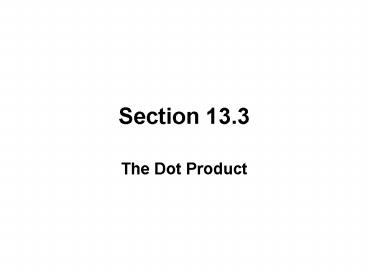The Dot Product - PowerPoint PPT Presentation
1 / 10
Title:
The Dot Product
Description:
section 13.3 the dot product the dot product properties of the dot product angle between two vectors orthogonal vectors direction angles direction cosines projections ... – PowerPoint PPT presentation
Number of Views:100
Avg rating:3.0/5.0
Title: The Dot Product
1
Section 13.3
- The Dot Product
2
THE DOT PRODUCT
If
, then the dot product of a and b is the
number a b given by
There is a similar definition for two-dimensional
vectors. NOTE The dot product is also called the
scalar product and the inner product.
3
PROPERTIES OF THE DOT PRODUCT
If a, b, and c are vectors in V3 and c is a
scalar, then 1. a a a2 2. a b b a 3.
a (b c) (a b) (a c) 4. (ca) b
c(a b) a (cb) 5. 0 a 0
4
ANGLE BETWEEN TWO VECTORS
Theorem If ? is the angle between vectors a and
b, then a b a b cos ? Corollary If ?
is the angle between vectors a and b, then
5
ORTHOGONAL VECTORS
Two nonzero vectors a and b are called
perpendicular or orthogonal if the angle between
them is p/2.
Theorem Vectors a and b are orthogonal if and
only if a b 0.
6
DIRECTION ANGLES
The direction angles of a nonzero vector a are
the angles a, ß, and ? (in the interval 0, p )
that a makes with the positive x-, y-, and z-axes.
7
DIRECTION COSINES
The cosines of the direction angles, cos a, cos
ß, cos ?, are called the direction cosines of the
vector a.
8
PROJECTIONS
- If vectors a and b are drawn with the same
initial point, the vector formed by dropping a
perpendicular from b onto a is called the vector
projection of b onto a and is denoted by proja
b. - The scalar projection of b onto a (also called
the component of b along a) is defined the be the
magnitude of the vector projection and is denoted
by compa b.
9
PROJECTIONS (CONCLUDED)
Scalar projection of b onto a Vector
projection of b onto a
10
WORK
Suppose an object is being pushed and the
constant force applied is a vector F that is
pointing in some other direction than the
direction of motion. The displacement vector is
D, the vector formed by the movement of the
object from point P to point Q. The work done by
this force is defined to be the product of the
component of force along D and the distance moved.
W F D































